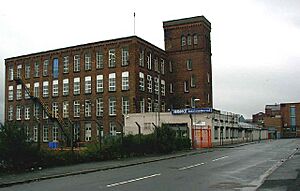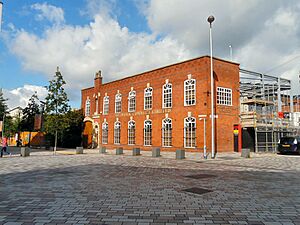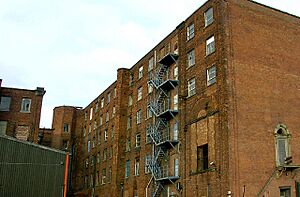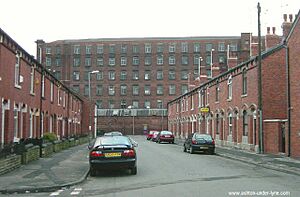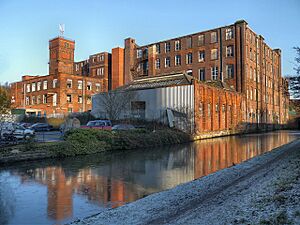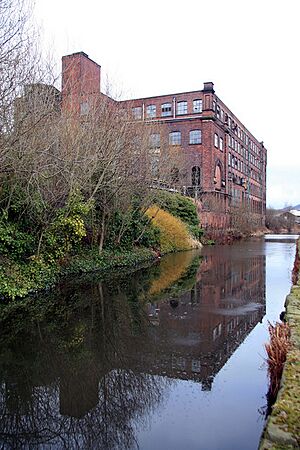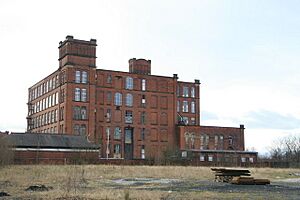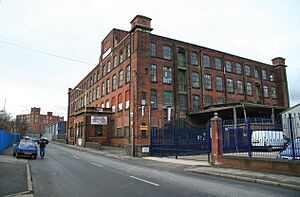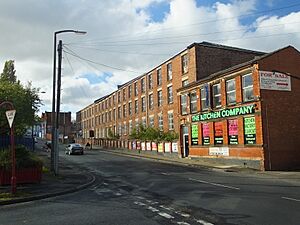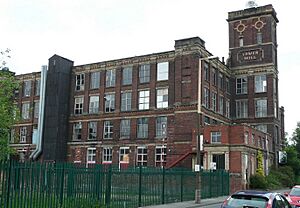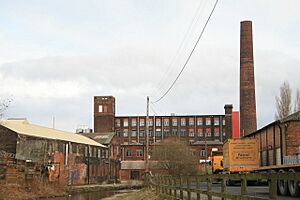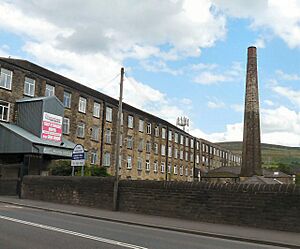List of mills in Tameside facts for kids
Tameside, a group of towns in Greater Manchester, England, was once a huge center for making textiles, especially cotton. From the time of the Industrial Revolution (when machines changed how things were made) until the 1900s, the valleys of the River Etherow and River Tame were filled with large brick factories called mills. Many of these old buildings are still around today, used as warehouses, homes, or shops. This article tells you about some of these important mills.
Contents
Mills in Ashton-under-Lyne
Ashton-under-Lyne had many textile mills. Here are some of them:
- Ashton Mill: This mill started as a place to grind corn. It was powered by two large waterwheels. In 1788, a new mill was built. By 1803, it had machines for carding (preparing cotton), drawing, roving, and spinning cotton into yarn. It was partly rebuilt in 1848 and closed in 1892.
- Atlas Mill: Built in 1900, this mill was a big spinning factory. It was taken over by the Lancashire Cotton Corporation in 1930 and closed in 1994. Now, homes stand where the mill once was.
- Cavendish Mill: This mill was built in 1885. In 1994, it was turned into apartments, and it's still standing today.
- Cavendish Street Mill: Not to be confused with Cavendish Mill, this factory had 72,000 spindles by 1891, spinning different types of cotton yarn.
- Cedar Mill: Built in 1905, this mill was also part of the Ashton Syndicate. It later became part of the Lancashire Cotton Corporation and then Courtaulds. It was likely torn down around 1988.
- Cockbrook Mill: In 1891, this mill had 31,000 spindles, making twist cotton yarn.
- Duncan Street Mill: Built around 1860, this mill had 60,000 spindles in 1891, producing both twist and weft yarn.
- Egret Mill: The spinning part of this mill burned down in 1881 and was replaced with weaving sheds. The office building, built in 1824, was still standing in 2013.
- Fern Mill: This mill, built in 1895, was an extension of Ryecroft Mill. It is now owned by Hills Biscuits, who plan to demolish it for a new warehouse.
- Gas Street Mill: In 1891, this mill, along with Whitelands Weaving Shed, had 58,000 spindles and 755 looms.
- Good Hope Mill: Built in 1824, this mill had 28,000 spindles by 1891, making weft yarn.
- Grosvenor Mill: This mill, built in 1891, had 30,000 spindles.
- Guide Bridge Mill: This large mill, built in 1876 and 1884, had over 150,000 spindles by 1891. An earlier part of the mill was demolished in 1938.
- Guide Mill: Built in 1842, this mill had 56,000 spindles in 1891, making hosiery yarn and twist. Its upper floors have since been removed.
- Harper Mill: This mill was rebuilt in 1873 after a fire. It has now been converted into apartments.
- Hurst Mill: Once a busy mill, it has now been demolished and replaced by a housing estate.
- Junction Mills: These mills, built between 1831 and 1890, had 48,000 spindles and 1,126 looms by 1891. Most of the mills have been demolished, but the chimney remains.
- Lees Street Mill: In 1891, this mill had 15,000 spindles for doubling (making stronger yarn) and reeling.
- Minerva Mill: Built in 1892, this mill was demolished in 1937.
- Oxford Mill: Built in 1845, this mill had 75,000 spindles by 1891, used for spinning and doubling.
- Portland Street Mill: By 1891, this mill had 48,000 spindles, making twist and weft yarn.
- Rock Mill: Built in 1893 on the site of an older mill, it used the old mill's chimney. It was demolished in 1971.
- Ryecroft Mill: Built in 1834, this mill had 59,000 spindles and 357 looms by 1891.
- Tame Valley Mill: In 1891, this mill had 15,000 spindles for making thread.
- Texas Mill: Built in 1907, this mill was part of the Ashton Syndicate and later the Lancashire Cotton Corporation. It burned down in 1971.
- Tudor Mill: Built in 1903, this mill was also part of the Ashton Syndicate and later the Lancashire Cotton Corporation. It burned down in 1970.
- Union Mill: In 1891, this mill, along with Walk Mill, had 92,500 spindles.
- Victoria Mill: By 1891, this mill had 27,000 spindles.
- Waterside Mill: In 1891, this mill had 34,602 spindles.
- Wellington Mill: Built in 1857, this mill had over 76,000 spindles and 2,004 looms by 1891. It is still standing.
- Wharf Street Mill: Built in 1825, this mill had 84,000 spindles by 1891. It was demolished in 1987 and replaced by a supermarket.
- Whitelands Mill: Built in 1883, this mill had nearly 129,000 spindles by 1891. It was later used by A. V. Roe & Co. and Sterling Moulding Materials.
- Wilshaw Mill: This mill was replaced by Rock Mill before 1893.
Mills in Droylsden
Droylsden also played a part in the textile industry:
- Albion Mill: In 1891, this mill had 22,548 spindles.
- Angola Mill: This mill had 257 looms by 1891.
- Droylsden Mills: By 1891, these mills had 39,000 spindles.
- Edge Lane Mill: In 1891, this mill had 41,640 spindles.
- Fairfield Mills: These mills had 30,000 spindles and 710 looms by 1891.
- Lumb (Littlemoss) Mill: By 1891, this mill had 45,000 spindles.
- Oakfield Mill: In 1891, this mill had 24,000 spindles.
- Royal Mill: This mill had 45,000 spindles by 1891.
- Saxon Mill: Built in 1907, this mill was part of the Ashton Syndicate and later the Lancashire Cotton Corporation and Courtaulds. It closed in the 1960s and was demolished in 1995.
- Victoria Mill: Built in 1847, this mill had 44,500 spindles by 1891.
Mills in Dukinfield
Dukinfield was home to many important mills, some of which were quite large and advanced for their time.
- Albert Mill: Built in 1873-74, this mill had 48,000 spindles, later increasing to 57,000. It stopped spinning in 1932 and was demolished in 1947.
- Aqueduct Mill / Dukinfield Mill: Built in 1841, this mill was small with four floors and 13,584 spindles. It later became Aqueduct Mill in 1893 and was used for doubling cotton (making stronger thread) until around 1940, then demolished.
- Astley Mill: Built in 1883, this large mill had 35 pairs of "mules" (spinning machines) and was powered by a huge steam engine. It could spin both twist and weft yarn. It closed in 1931 and was demolished in 1935.
- Barn Meadow Mill: Built around 1835, this was the first mill in Dukinfield that combined spinning and weaving. It closed in 1884 and was demolished in 1985.
- Bridge Eye Mill: The first part of this mill was built in 1815. By 1833, it had three steam engines and employed 1134 people for spinning and weaving. It closed in 1884 and was demolished by 1910.
- Chapel Hill Mill: Built around 1792, this mill started with a steam engine by 1803. It was used for spinning and later weaving. It closed in 1962 and was demolished in the 1970s.
- Dukinfield Hall Mill: This mill was known for spinning 36 counts of twist and weft yarn. It closed in 1894 and was demolished in 1895.
- Dukinfield New Mill: Built in 1802, this steam-powered mill had 12,480 spindles by 1811. It was even used as army barracks for a time! It was destroyed by fire in 1866 and again in 1933.
- Dukinfield Old Mill: The oldest part of this mill was built in 1792 and was water-powered. It was expanded several times, including a large extension in 1894. It continued spinning until 1953, and the 1894 part was still standing in 1993.
- Furnace Mill: Built in 1792, this mill used a waterwheel powered by the River Tame. It was extended in 1825 and later destroyed by fire in 1868.
- Old Hall Mill: This mill, built around 1864, was a weaving shed. It was rebuilt after a fire in 1906. It closed in 1933 and was demolished.
- Oxford Road Mills: Started in 1815, these mills were known for spinning and weaving. Weaving stopped by 1898, and the mills were later converted to use "ring frames" for spinning. They closed in 1937 and were demolished.
- Park Road Mill: Built in 1891, this was a five-story mill with 92,280 spindles, considered very modern at the time. It spun coarse American cotton. It closed in 1965 and was demolished in 1995.
- Queen Mill: Designed by Sidney Stott and built in 1901, this large mill had 100,000 mule spindles. It became part of Fine Spinners and Doublers in 1954, closed in 1959, and was demolished in 1983.
- River Mill: Built in 1877, this four-story mill had 45,000 spindles. It stopped spinning in 1934 but the building found other uses.
- St Helens Mill: Started in 1819, this mill expanded over time and was even used for printing fabric. It stopped being a cotton mill in 1876, but the buildings are still standing.
- Stanley Wood Mill: Built around 1861, this mill had between 30,000 and 40,000 spindles. It closed in 1896 and was demolished by 1906.
- Tameside Mills: Built in 1852, this was a very large mill that expanded several times, reaching over 100,000 spindles for spinning and doubling. It closed in 1933, and most buildings were demolished.
- Tame Valley Mill: Built in 1853, this mill was taken over by Koch & Co. and expanded. It was renamed Crescent Mill in 1933 and continued to operate until 1996. It is still in use today for making technical textiles!
- Tower Mill: Built in 1885, this four-story mill was known for its ornate design and had 44,000 spindles. It stopped spinning in 1955. In 1996, it became a Grade II listed building, meaning it's historically important. In 2015, it was chosen to restart cotton production in Manchester, and by 2019, it was spinning cotton again using new technology!
- Union Mill: Built in 1850, this mill spun cotton and uniquely wove hose (stockings). It closed suddenly in 1883.
- Victoria Mill: Built in 1861, this mill had over 57,000 spindles. It stopped spinning in 1932 and was demolished in 1947.
- Warbrick's Mill: A very small mill built around 1825.
- Waterside Mill: Built in 1841, this small mill was later renamed Alma Mill and used for reeling, winding, and doubling. It closed around 1914.
Mills in Hyde
Hyde also had its share of cotton mills:
- Bayleyfield Mill, Carrfield Mill, and Throstle Bank Mill: These three mills were owned by Ashton Brothers and Co. In 1891, together they had 114,580 spindles and 2,200 looms.
- Gee Cross Mill: In 1891, this mill had 40,000 spindles.
- Gibraltar Mill: This mill had 28,674 spindles and 481 looms by 1891.
- Greencroft Mill: In 1891, this mill had over 26,000 spindles and 541 looms, making fabrics like shirtings and drills. It was later used by Crossley Motors (who made buses) and was finally demolished in the 1990s.
- Greenfield Mill: By 1891, this mill had 26,000 spindles and 451 looms.
- Hyde Mill: This mill was bought by the J.A. Pattreiouex company in 1960.
- Providence Mill: In 1891, this mill had 40,900 spindles.
- Slack Mill: By 1891, this mill had 58,892 spindles and 1,200 looms. It was taken over by the James North Company in 1960.
- Toray Mill: This mill has been demolished.
- Wharf Mill: This mill has also been demolished.
Mills in Mossley
Mossley had mills, including some for wool:
- Bottom Mills, Britannia, Southend, and Scout Mills: In 1891, these mills, owned by John Mayall, had a massive 420,000 spindles combined.
- Brunswick Mill: A textile mill in Mossley.
- Buckton Vale Print Works: A place where fabric was printed.
- Carr Hill Mills: In 1891, these mills had 84,600 spindles.
- Castle Clough Mill: In 1891, this was a woollen manufacturing mill.
- Clough Mill: A mill located near Micklehurst Brook.
- Croft Mill: Another mill in Mossley.
- Hollins Mill: A mill located near Micklehurst Brook.
- Milton Mill: A mill in Mossley.
- Squire Mill: This was a woollen manufacturing mill.
- Vale Mill: This was also a woollen manufacturing mill.
- Woodend Mill: A mill in Mossley.
Mills in Mottram
Mottram had some of the earliest mills:
- Albion Mill: A mill in Mottram.
- Dry Mill: This mill, built around 1790, was used for hand spinning and powered by horses, showing how early mills operated before steam engines.
Mills in Stalybridge
Stalybridge was a very important mill town, with many large factories:
- Adshead's Mill: Built in 1791, this mill used hand-operated spinning machines and later had a steam engine by 1795.
- Albion Mill: Built in 1824 and 1825, these mills were bought by Robert Platt and had 56,000 spindles. The company continued until 1983.
- Aqueduct Mill: Started in 1823-24, this mill was extended and had over 54,000 spindles by 1905. It was later converted to use "ring spindles" and produced carpet yarns. It was demolished in 1984.
- Bankwood Mill (a.k.a. Cheetham's): Built in 1831, this mill was run with Castle Street Mills and employed 1400 workers in 1871. It closed in 1935.
- Bannerman's Mills (North End and River Meadow): North End Mill was built in 1851, and River Meadow Mill was built across the river. They were used for spinning with 80,000 spindles. North End Mill was demolished, but River Meadow Mill survived for other uses before also being demolished.
- Bayley Street Mill: Built in the early 1830s, this mill was designed by William Fairbairn and had two floors with 1000 looms and 23,000 spindles. It was powered by large steam engines. The mills were demolished, leaving no trace.
- Bayley's Bridge Street Mill: Built in 1812, this mill added power weaving in 1824 and employed many people.
- Bayley's Queen Street Mill (a.k.a. Hope Mill): Built around 1800, this mill had about 9,000 spindles. It was later used for doubling and was demolished around 1900.
- Bridge Street Mills: Built in 1815, this seven-story mill was extended and later had 50,000 spindles. It operated until 1953 and was then demolished.
- Castle Mill: Built in 1891-92, this four-story mill had nearly 88,000 spindles and was powered by a large steam engine. It was taken over by the Lancashire Cotton Corporation in 1930 and demolished in 2009.
- Castle Street (Hall's) Mill (a.k.a. The Stone Factory): The first part of this mill was a six-story stone building from 1815. It closed in 1883 and was used for warehousing.
- Castle Street Mills (a.k.a. Longland's Mill): This mill had three lives. Built in 1805, it was a spinning mill. From 1920 to 1961, it was used for doubling. In 2010, it was restored into apartments and is still in use.
- Clarence Mill (a.k.a. Stamford Mill): Built in 1862 during the Lancashire Cotton Famine to create jobs, this five-story brick building had 70,000 spindles by 1884. It spun cotton and later rayon. It closed in 1960, but the building still stands and is used by various businesses.
- Copley Mill: Built in 1827, this mill was used for machine making and spinning. By 1930, it was used for cotton doubling and continued until 1974. The buildings are now used for multiple purposes.
- Garside's Mill: Built in 1798, this small mill had about 4,000 spindles. It was likely demolished around 1840 for the railway.
- Grosvenor Street Mills: These mills, including Old Mill, Castle Mills, and Clock Tower, started in 1805. They expanded greatly, employing 1300 people by 1832. Most buildings were demolished by 1934, but the Clock Tower Mill continued until 1955.
- Hen-cote Mill: This mill was demolished by 1845.
- Heyrod Mill: Built in 1788, this five-story mill used water frames and later mules and throstles. It was converted into a print works around 1850 and demolished around 1930.
- Higher Mill: This mill, originally for wool, converted to cotton around 1803. It suffered fires in 1827 and 1873. The site was later used for a paper mill.
- Hollins Mill: Built in 1826, this four-story mill closed in 1882 and was demolished by 1896.
- Kershaw Wood Mill: Built in the mid-1830s, this mill had space for 40,000 spindles. It was bought and demolished by the railway company in 1878 for a station that was never built.
- King Street Mill: Built around 1800, this mill had 5,600 spindles. A new mill was built in 1850 but was demolished before 1892.
- Lilley's Mill: Built in 1790 as a woollen mill, it had the earliest steam engine in the district in 1802. It was later converted into cottages and demolished around 1857.
- Oakwood Mill (New Mill, Millbrook): Built in 1851, this stone-built mill spun cotton. It stopped spinning in 1962 and is now derelict.
- Old Street Mill: One of the earliest mills, possibly from 1790.
- Phoenix Mill: Built between 1831 and 1845, this mill was used for cotton weaving.
- Premier Mill: An unusual single-story mill designed in 1906, powered by electric motors. It had 21,000 ring spindles and 1017 looms. It was part of Victor Mill Ltd and continued production until 1982. The mill was still standing in 1990.
- Quarry Street Mill: The first part of this mill was built in 1834. A second mill was built later. Mill No. 1 was destroyed by fire in 1915 but rebuilt. It later became a rubber company and has since been demolished and replaced by housing.
- Queen Street Mill: Built in 1804, this mill was destroyed by fire in 1823. The new mill had 12,500 doubling spindles. It was demolished shortly after 1906.
- Rassbottom Mills: This is a group of mills in Stalybridge, including Chapel Street Mill (1797). These mills were very large, with thousands of spindles and looms, and employed many people. Many were demolished by the railway company, but some parts are still standing.
- Ray Mill: A five-story, electrically driven mill built in 1907. It had over 66,000 ring spindles. It was part of Victor Mill Ltd and continued production until 1982. The mill was destroyed by a fire in 2018.
- Riverside Mill: A weaving shed built in 1884 with 1200 looms. It later added ring spindles and operated as a combined mill until 1930. It closed in 1962, but the building still survives as part of a larger factory.
- Robinson Street Mill (a.k.a. Aqueduct Higher Mill, Nuttall's Mill): Built in 1824, this mill had 46,000 mule spindles and later added 20,000 ring spindles. It closed and was demolished in the 1920s.
- Soot-poke Mill: Built in 1776, this was the very first cotton mill in Stalybridge. It was a small, cottage-sized mill, initially water-powered, then had a steam engine by 1790/91. It burned down in 1824.
- Spring Grove Mill: The last water-powered mill built in 1818. It employed 115 people for spinning. It was sold for woollen manufacturing in 1868 and the building burned down in 1882.
- Staley Mill (Howard's) (a.k.a. Swineshaw Mill, Castle Hall Mill): An old corn mill converted to cotton around 1800. It was rebuilt after a fire and later became a woollen mill, working until 1962.
- Staley New Mills: Built in 1824 and the 1830s, these mills had 58,000 spindles. They were demolished around 1983.
- Stalybridge Mill: A mill located in Stalybridge.
- Valley Mill: A stone-built woollen mill that later spun cotton. It disappeared from records between 1872 and 1896.
- Victor Mill: A beautiful Edwardian mill built in 1903, designed for "ring spinning." It had 77,000 spindles. It was part of Victor Mill Ltd and continued production until 1982. The mill was demolished in 1985.
- Water Street Mill: Built in 1797, this was a purpose-built steam-powered mill with 13,000 spindles. It was demolished by 1896.
- Wareing's Mill: A small mill built in 1821 with 10,824 spindles. It stopped spinning in 1896 but remained standing for other uses until 1970.
Images for kids



